Chicken, slowly smothered in a rich brown gravy until it’s falling apart. Layers of flavor are built on a light roux, the Trinity with garlic, South Louisiana Herbs and Spices and a gravy made with a rich stock. Most South Louisiana families have coveted family recipes for Smothered Chicken or Stewed Chicken. This is Sweet Daddy D’s no-angst recipe for this Cajun country classic.
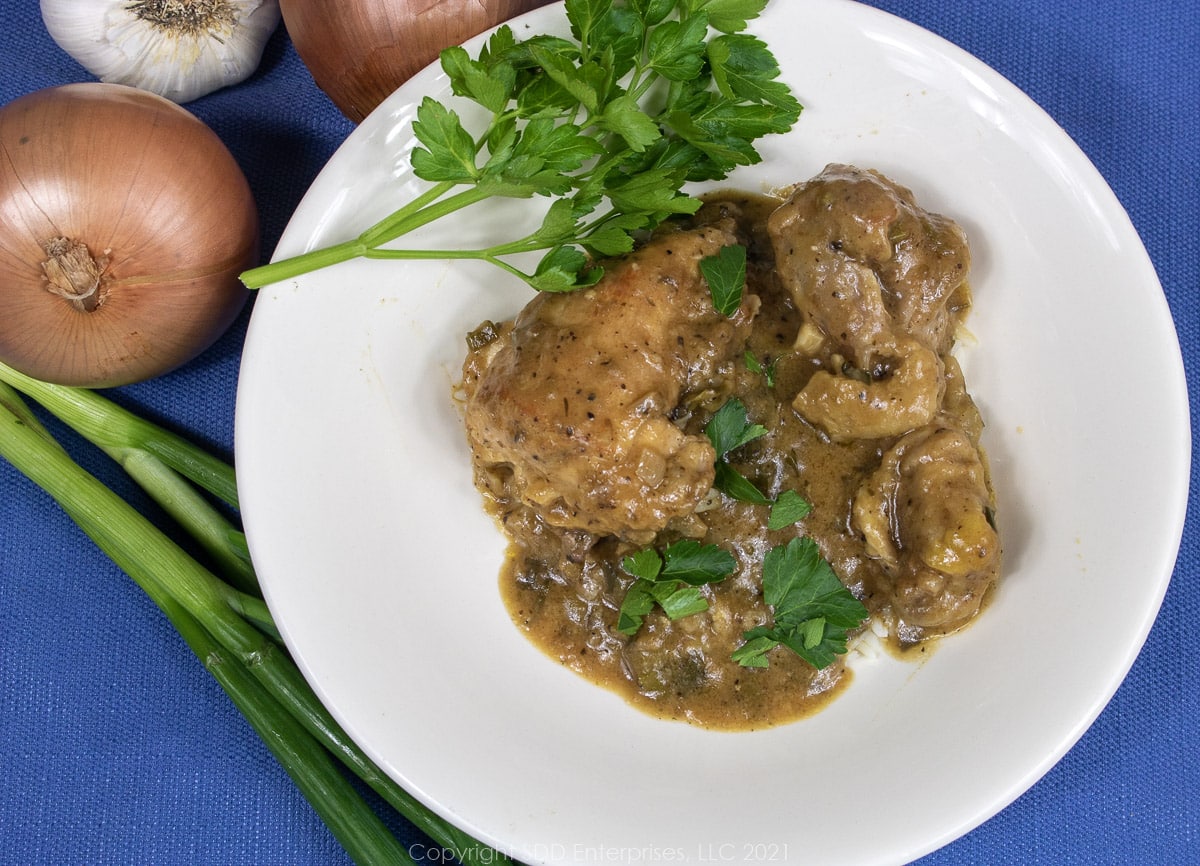
This post is not sponsored, but you will find affiliate links on this page. As an Amazon Associate, I earn from qualifying purchases. The price you pay as a consumer does not change, but I may make a small commission based on your purchase.
If you want to just skip to the recipe, click the "Jump To Recipe" button above or the Recipe link below and you’ll go right there without having to scroll through my article.
Classic Cajun Cooking
This is a perfect example of Cajun Cooking: simple ingredients and simple methods. The origins of Classic Cajun cuisine features local and readily available ingredients. So Chickens, probably raised at home or nearby and the basic vegetables for the Trinity that are grown in the back yard or on a nearby small farm made this dish a staple of the Cajun table. Add herbs and spices from the Herb garden and as much or as little pepper as the palate desires and you're on your way. Great Cajun flavors are the result of preparing these simple ingredients with simple processes: one-pot cooking. Many Cajun classics, including Jambalaya and Gumbo, are one-pot wonders as is Sweet Daddy D's Smothered Chicken. From start to finish, that big cast-iron Dutch oven is all you'll need.
Here’s What You Need
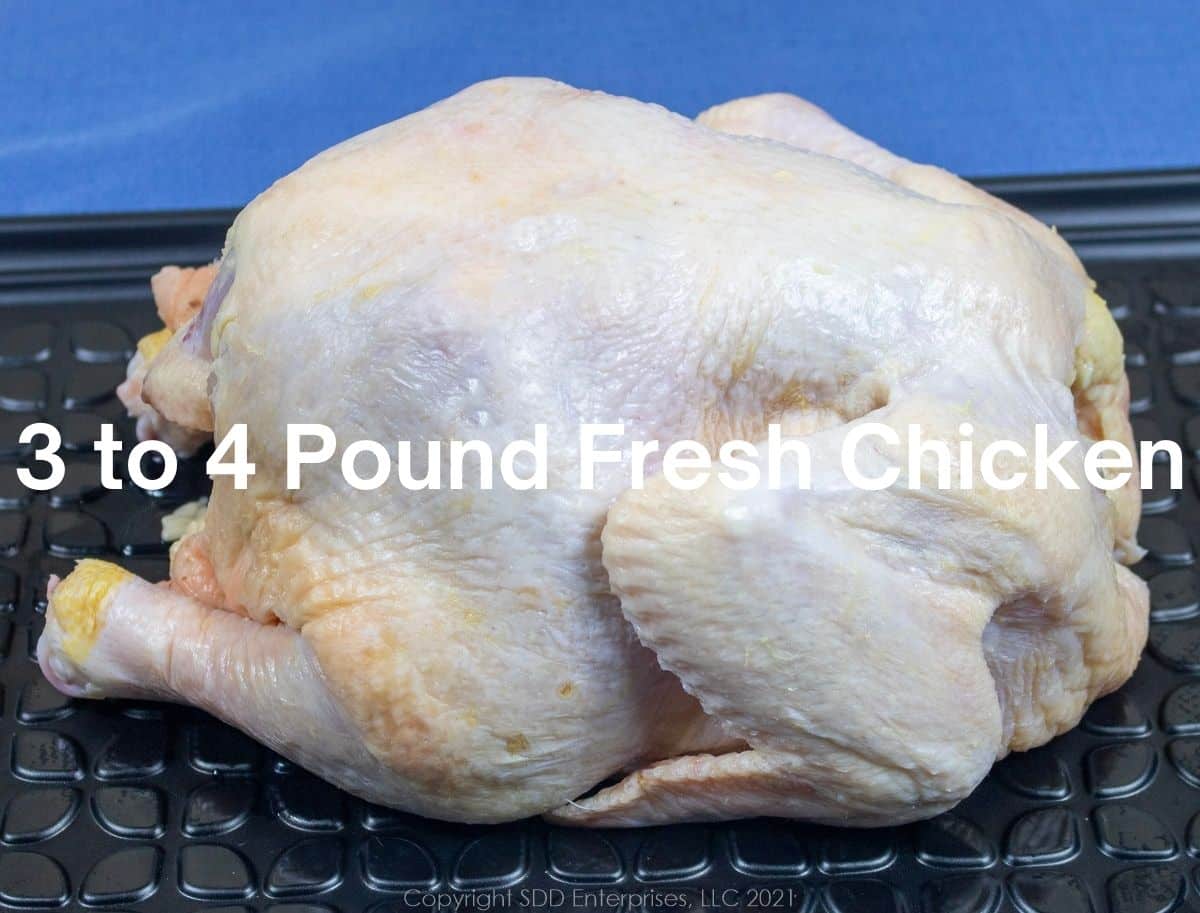
I like to start with a whole chicken and cut it up into manageable pieces. You can also use specific pieces if you want. Maybe you only like white meat, so just buy a few pounds of breasts. Thighs are great for this as I think the dark meat is very flavorful and will remain moist throughout the cooking process. A quicker and simpler option is to use a store-cooked rotisserie chicken. Check out the Hints and Tips section below for how to do that.
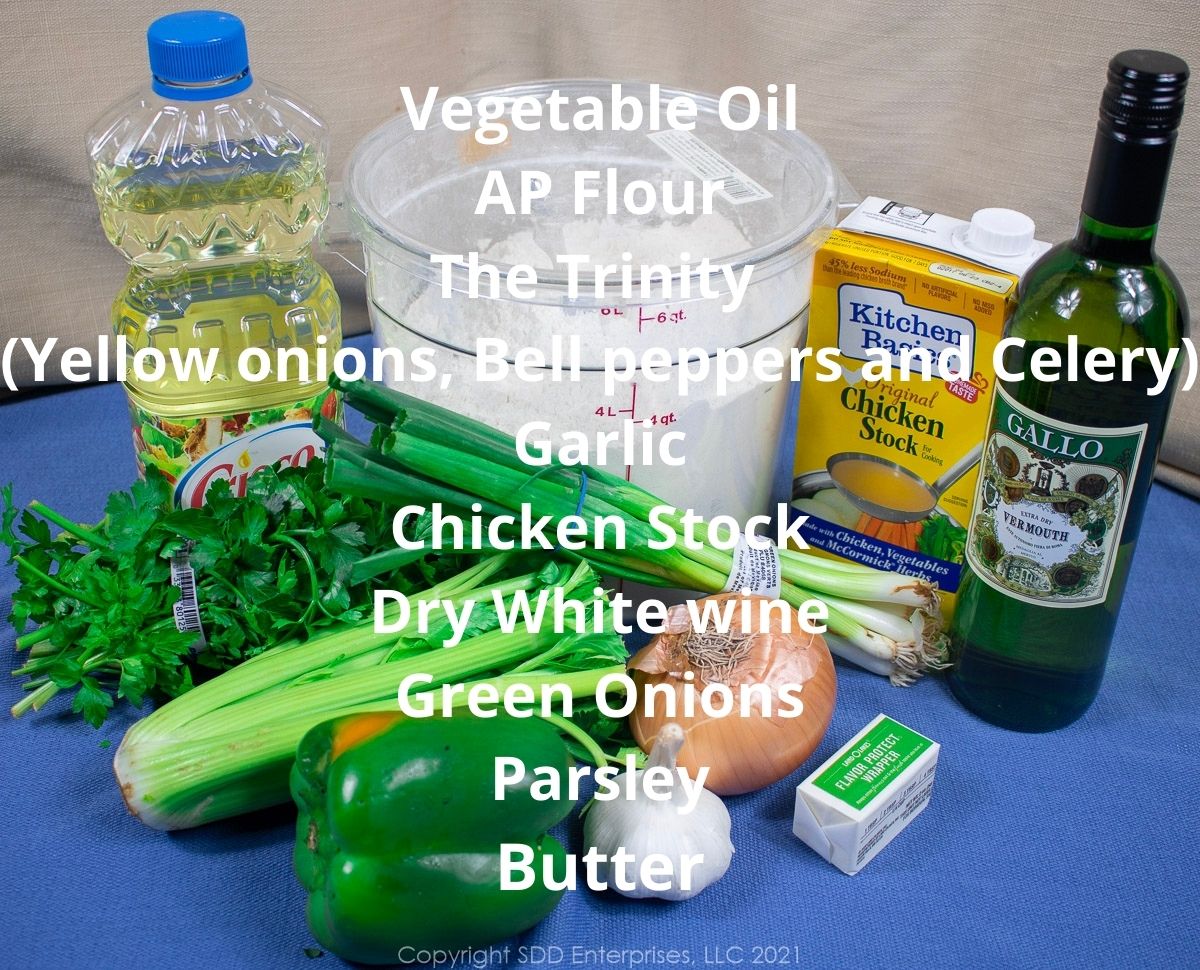
These basic ingredients are pretty standard. The recipe is built around a roux and the Holy Trinity (yellow onions, bell peppers and celery). Some ingredient substitutes are discussed in the Hints and Tips section below. Using Homemade Chicken Stock is a great option in lieu of the commercial stock. You can use cut-up fresh chicken to make the stock then use that same chicken in this recipe. Head down to the Hints and Tips section for how to do this.
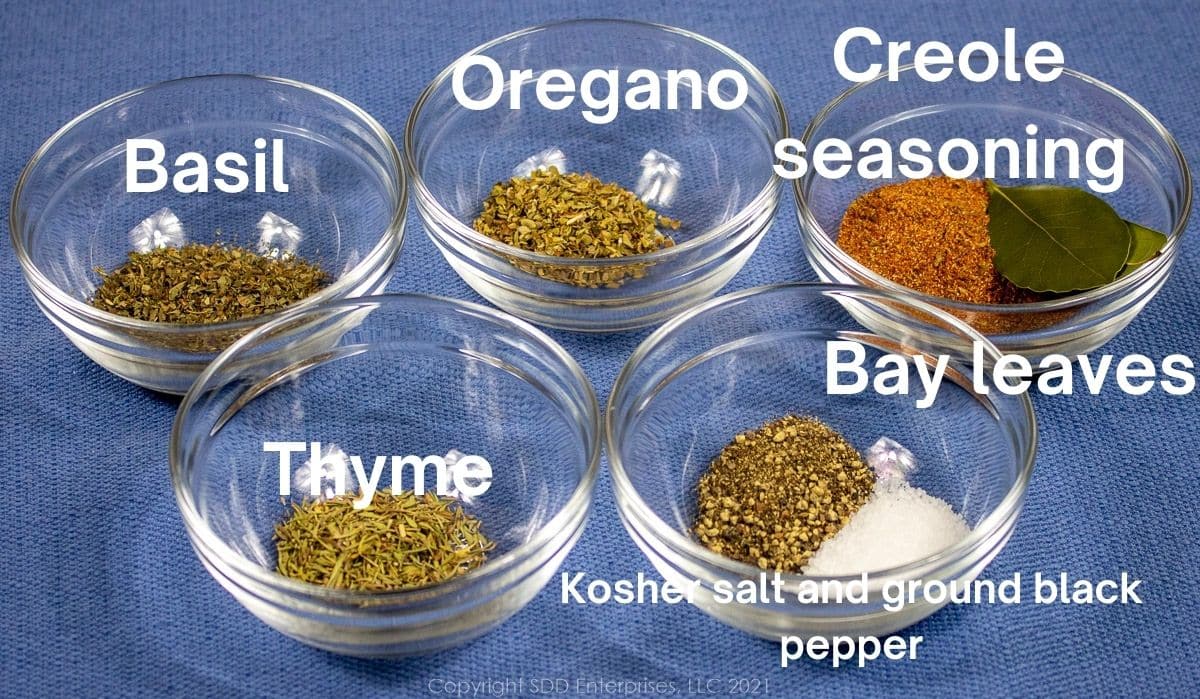
Keep in mind that many commercial Creole seasonings (as well as commercial stock) can contain a lot of salt, so you may want to hold back on the salt until you can taste the recipe. My own Le Bon Papa Creole Seasoning contains no salt or MSG. Click the image below to order some!

Equipment
I use a large Dutch oven for this. I also utilize both Cambro and Glass Prep bowls, measuring cups, chef's knife and cutting boards.
Here’s What You Do
First...you have a beer. The key to no-angst cooking is mise en place, which includes preparing the cook as well as the ingredients and equipment. Start by sitting down with a beer to read the recipe from start to finish. This brief respite will give you an understanding of what you'll need and what you will do with each ingredient.
Mise en place
Gather all of your ingredients and equipment and prep everything before you start cooking. Cut the chicken into serving pieces and sprinkle them with kosher salt, ground pepper and Creole seasoning. Set the chicken aside.
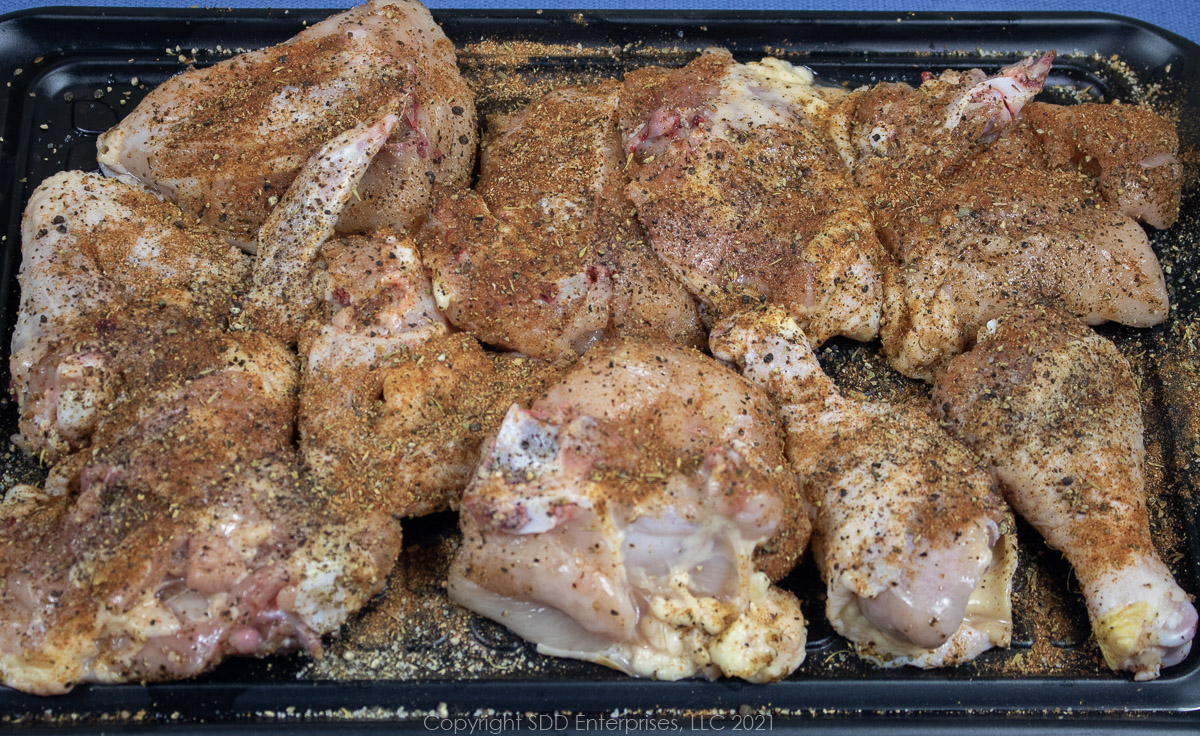
Chop the Trinity (yellow onion, bell pepper and celery) and place them all in the same prep bowl. Smash the garlic and measure all the other ingredients including the wine and stock.
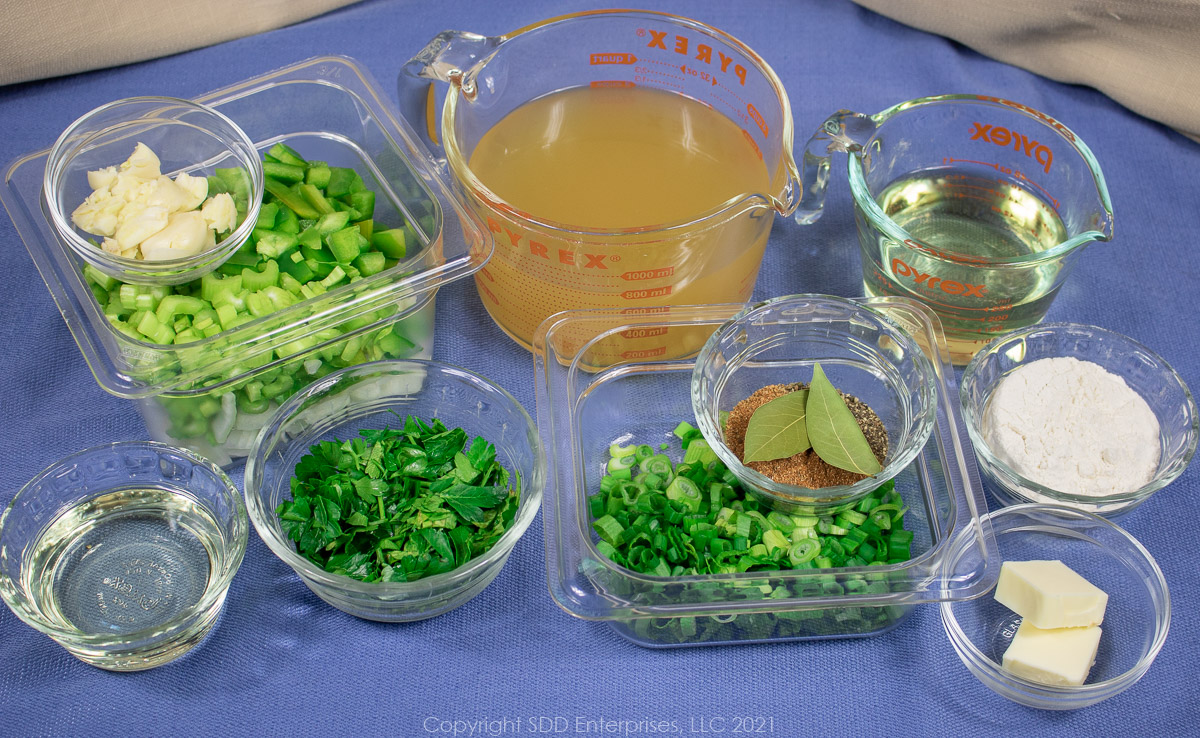
Build some flavor in the pan
What happens in this step? Depth of flavor is built in layers, each adding flavor and color that contribute to the final dish. We start by extracting some chicken flavor before adding the next layer with the Trinity, garlic, Herbs and Spices and a light brown roux. Here's how to build this flavorful foundation for the gravy.
Dredge the chicken pieces in the AP flour, shake off the excess flour and set these aside. Place a Dutch oven over medium heat and brown the chicken pieces in some hot oil turning often to get a good sear on all sides.
[Here's my pro tip: set the heat to medium but give it enough time for the oil to get hot. You are looking for around 350 degrees Fahrenheit which can be reached with medium heat if given the time. This will make the heat easier to control so that you don't scorch the chicken or the roux]
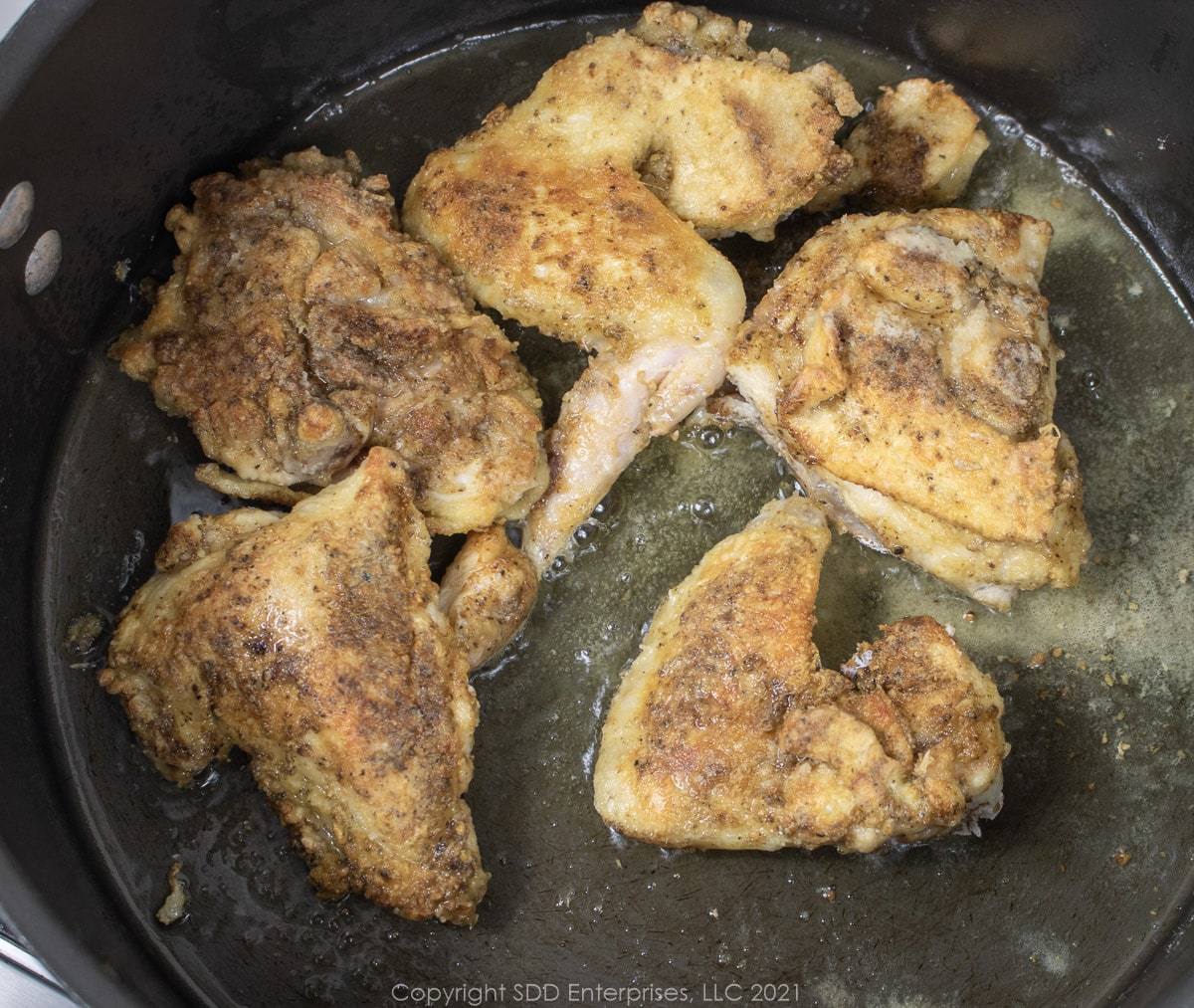
Remove the chicken and set it aside.
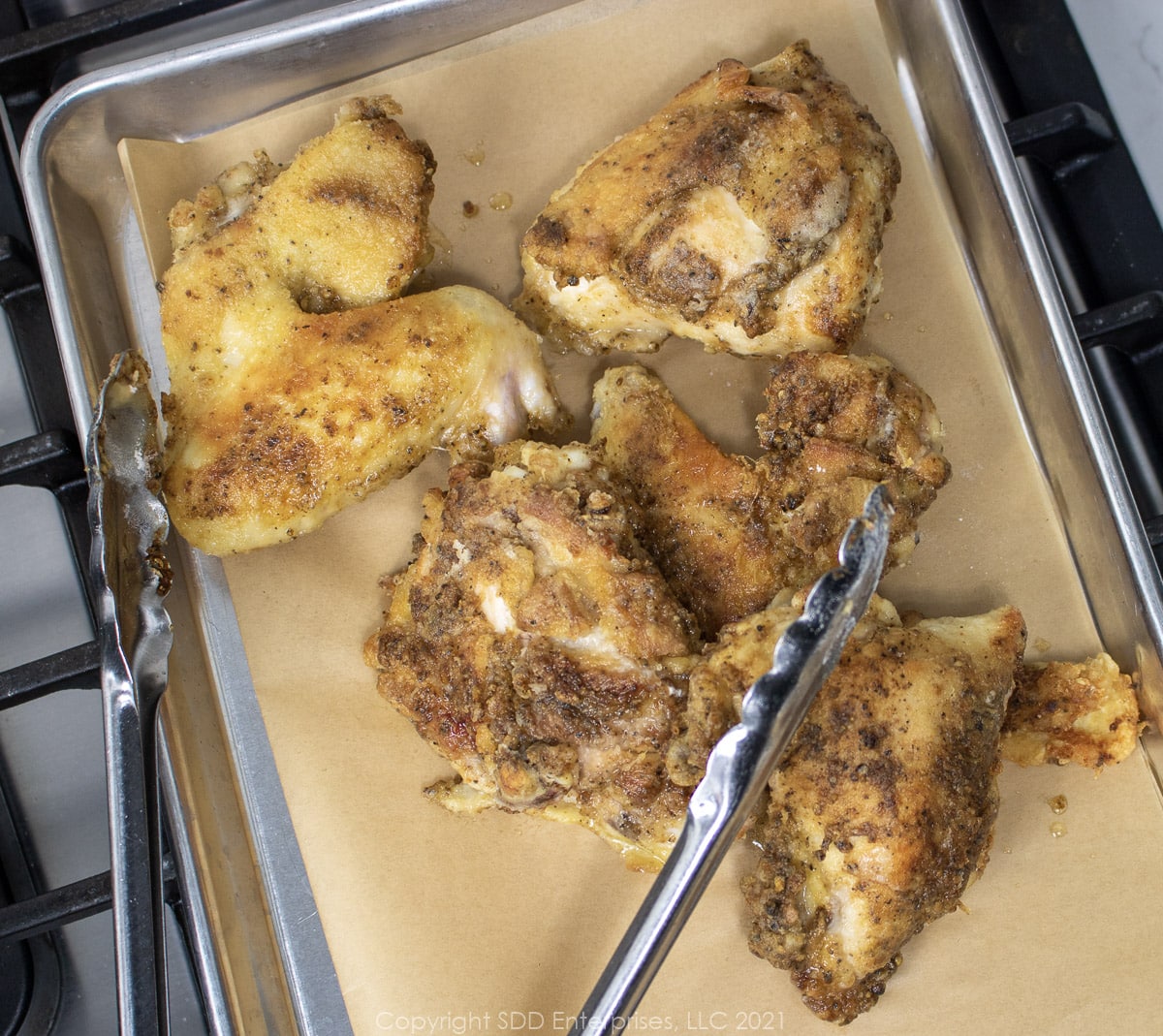
Maintaining a medium heat, make a light roux. Add the vegetable oil to the Dutch oven and give it time to get hot enough to shimmer. Add the AP flour into the vegetable oil and whisk constantly for about 8 minutes. If the roux is browning too fast, simply remove it from the heat. Add the Trinity and saute for another 8 minutes, stirring often until the onions are softened and beginning to get translucent.
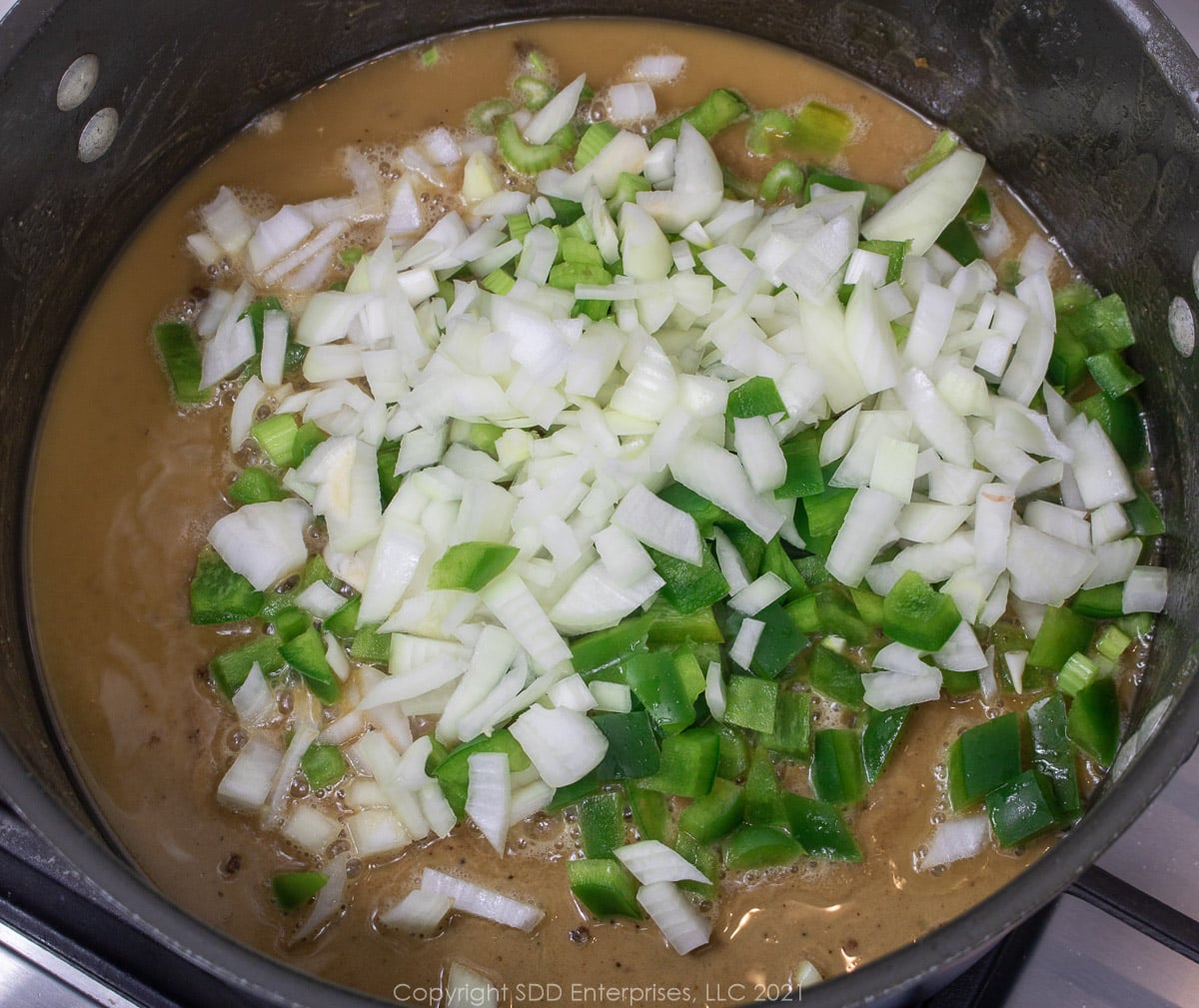
Add the garlic and the Herb and Spice Blend (without the Bay Leaves); stir constantly until aromatic which will only take about 2 or 3 minutes.
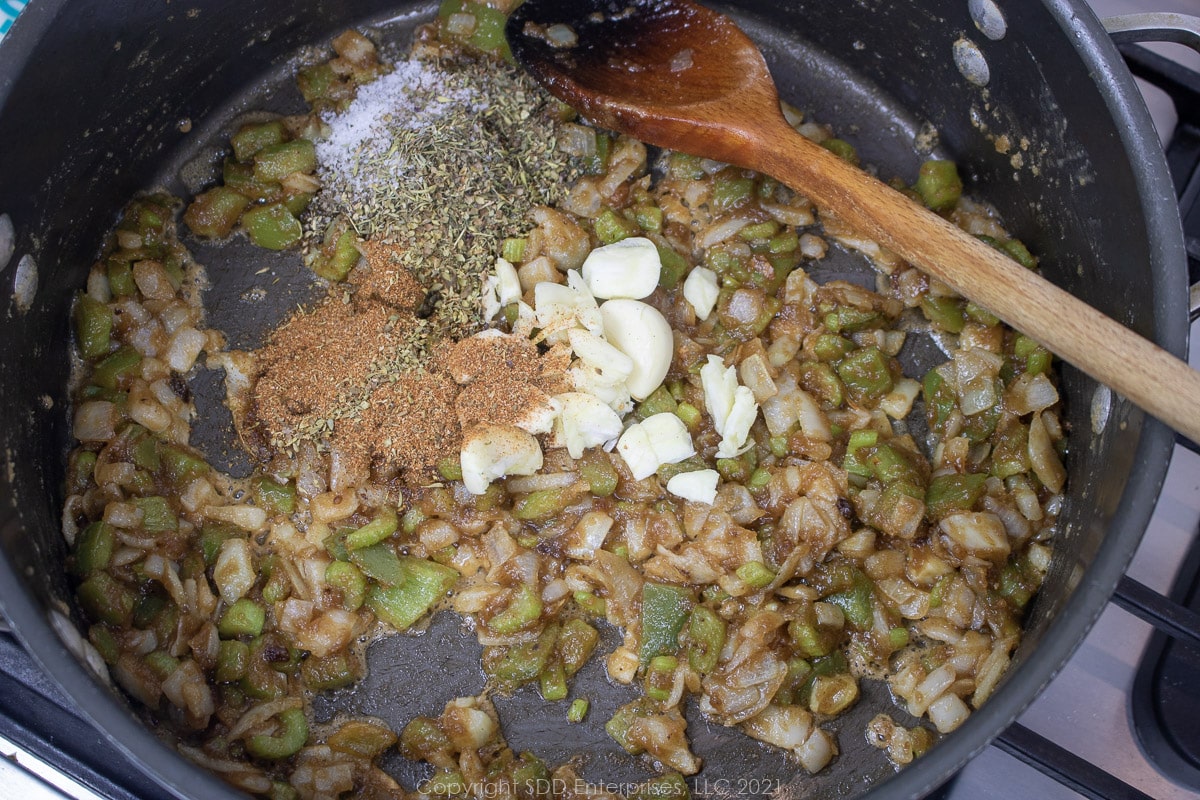
Make the gravy
What happens in this step? To this flavor base, you will add the stock. This is the layer of flavor that helps incorporate all the other flavors and seasonings and provides an environment in which to cook the chicken.
There is a lot of flavor on the bottom of the Dutch oven, so you’ll want to use a little of the stock to deglaze the pan and mix that fond into the gravy. This is flavor gone mad!
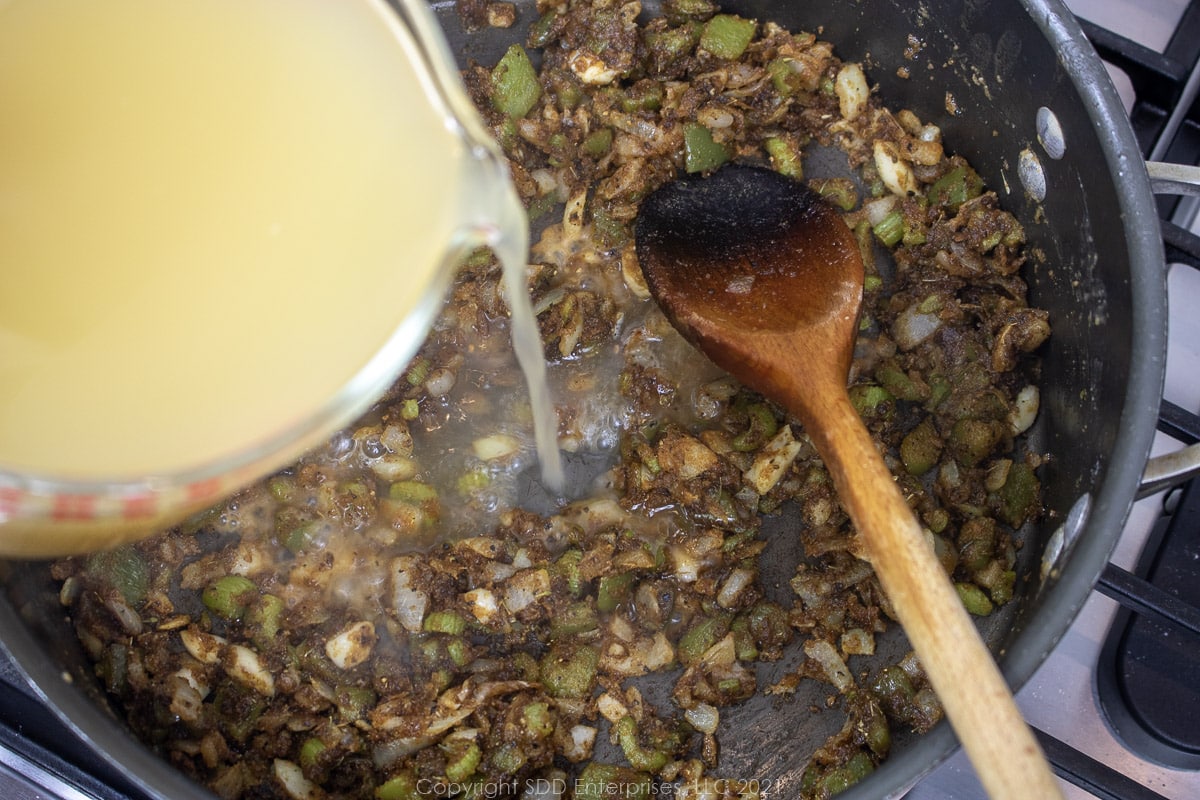
Now, slowly add the rest of the stock and the wine. To make sure no lumps develop, add the stock about 1 cup at a time, stirring or whisking constantly making sure everything is incorporated before adding more.
[Yet another pro-tip: out of the total 5 cups of stock, add only 4 cups at this time, reserving the rest in the event the gravy becomes too thick as it cooks].
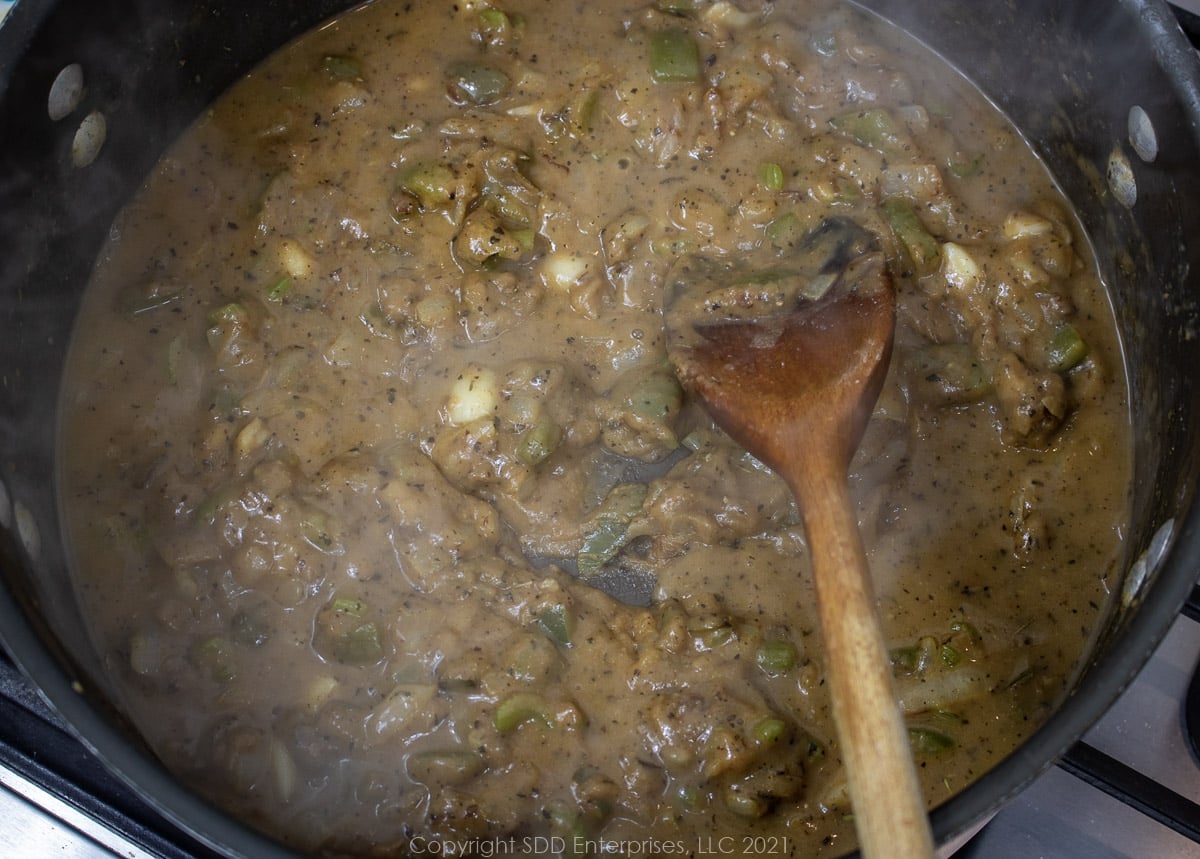
Once all the liquid is mixed into the roux, increase the heat to high, add the bay leaves and bring the gravy to a medium boil for about 5 to 10 minutes, uncovered. Stir occasionally.
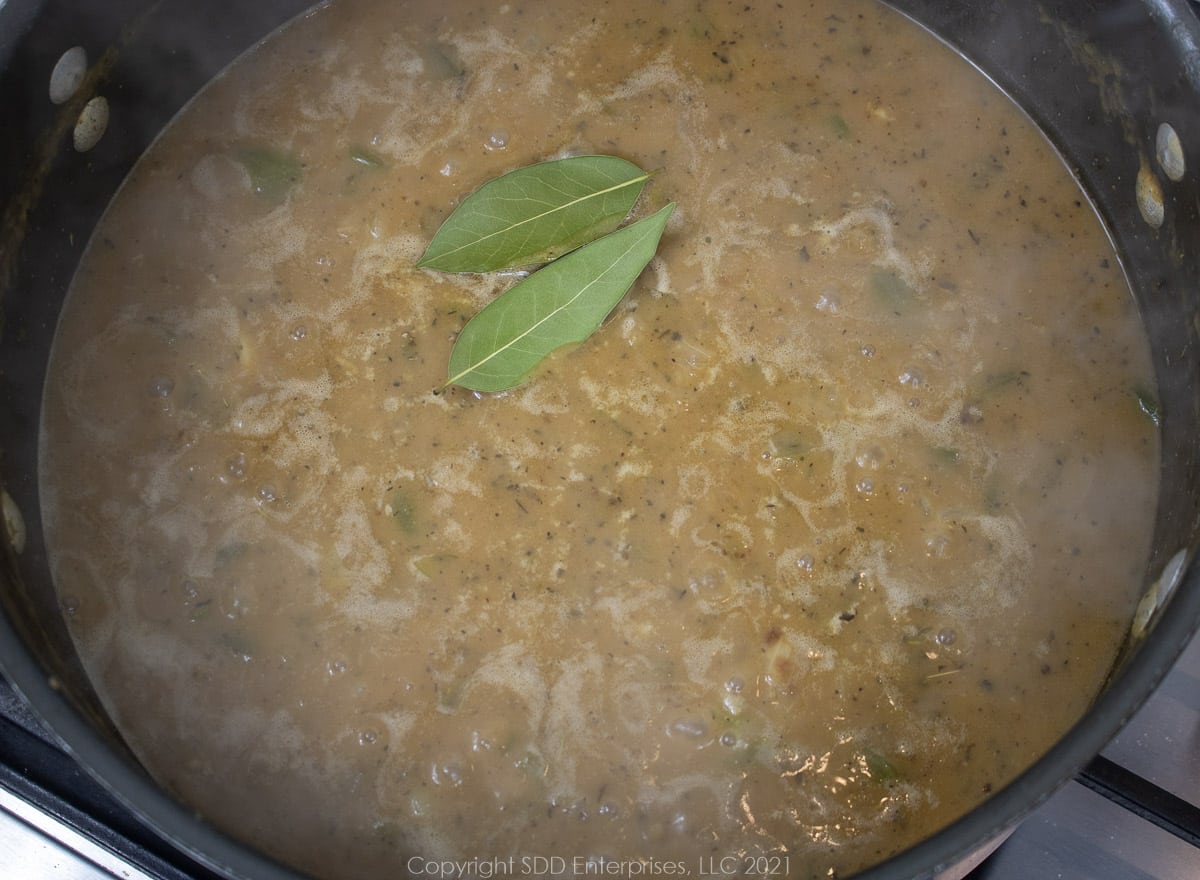
Smother the chicken
What happens in this step? The chicken is added to the gravy so that it can slowly cook until it’s almost falling apart and the juices and flavors incorporate into the gravy. Here's how you do it:
After the gravy has simmered for 5 to 10 minutes, add the chicken back to the Dutch oven, making sure each piece of chicken gets coated with gravy. Return the gravy to a boil before reducing the heat to a low simmer. Cover the Dutch oven and slowly simmer for about an hour or until the chicken is falling off the bone. Make sure to stir regularly so the chicken does not stick.
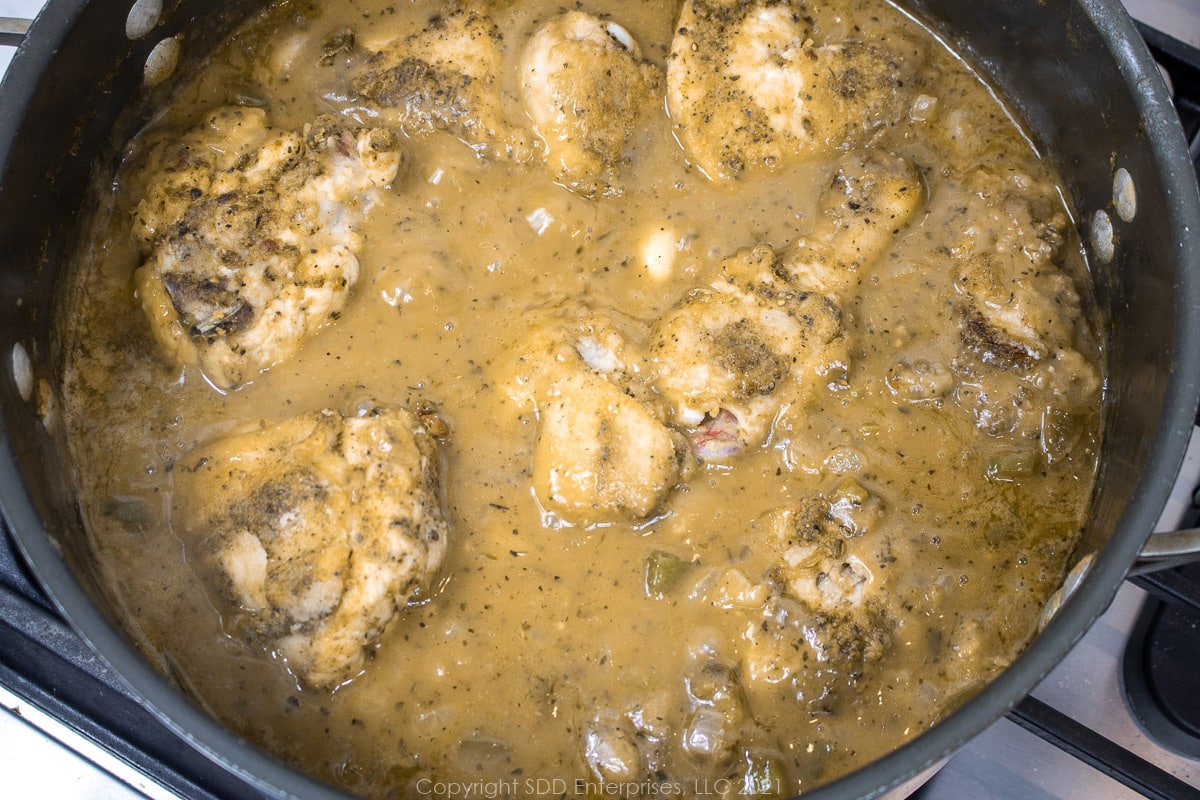
About 15 minutes before the chicken is ready add the green onions, parsley and butter. Stir well to combine and simmer some more.
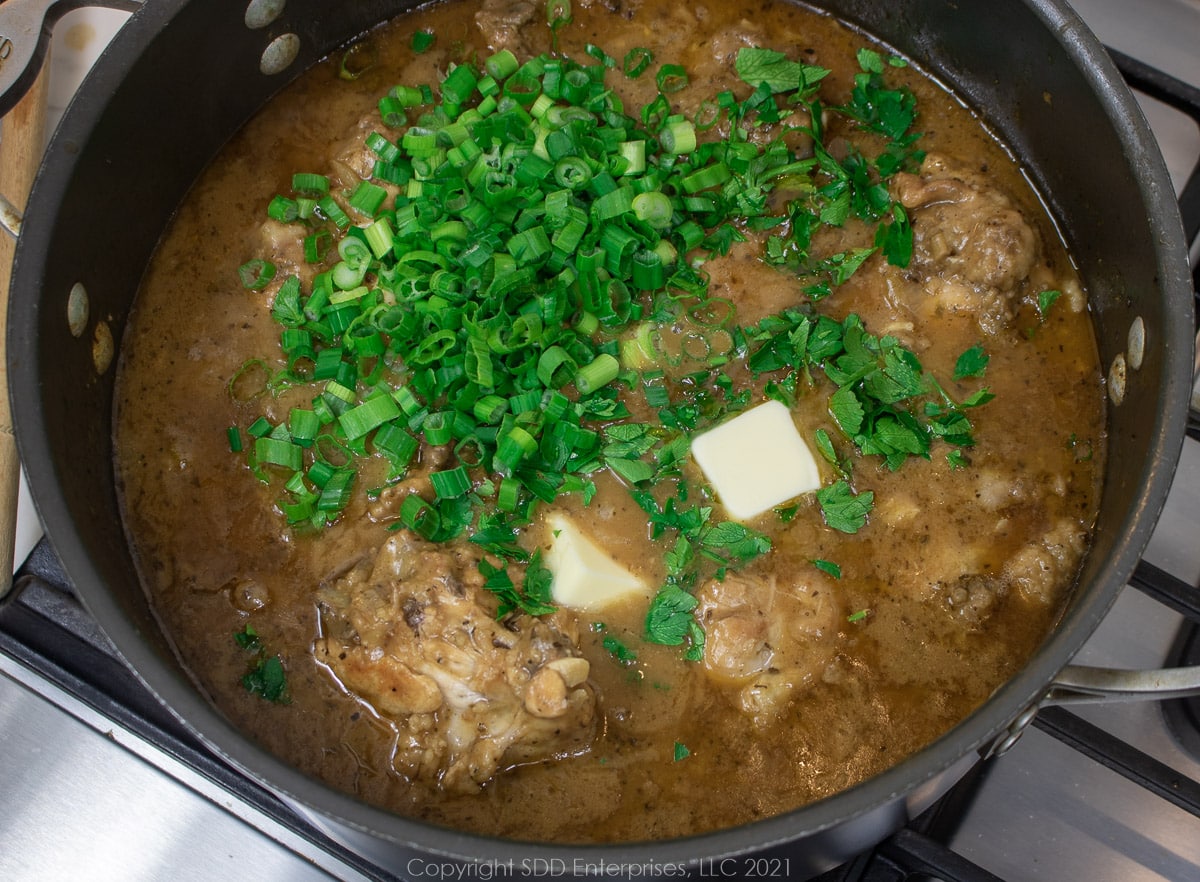
When the butter is completely melted and mixed into the gravy, it is ready. Let it sit about 10 minutes then serve over rice.
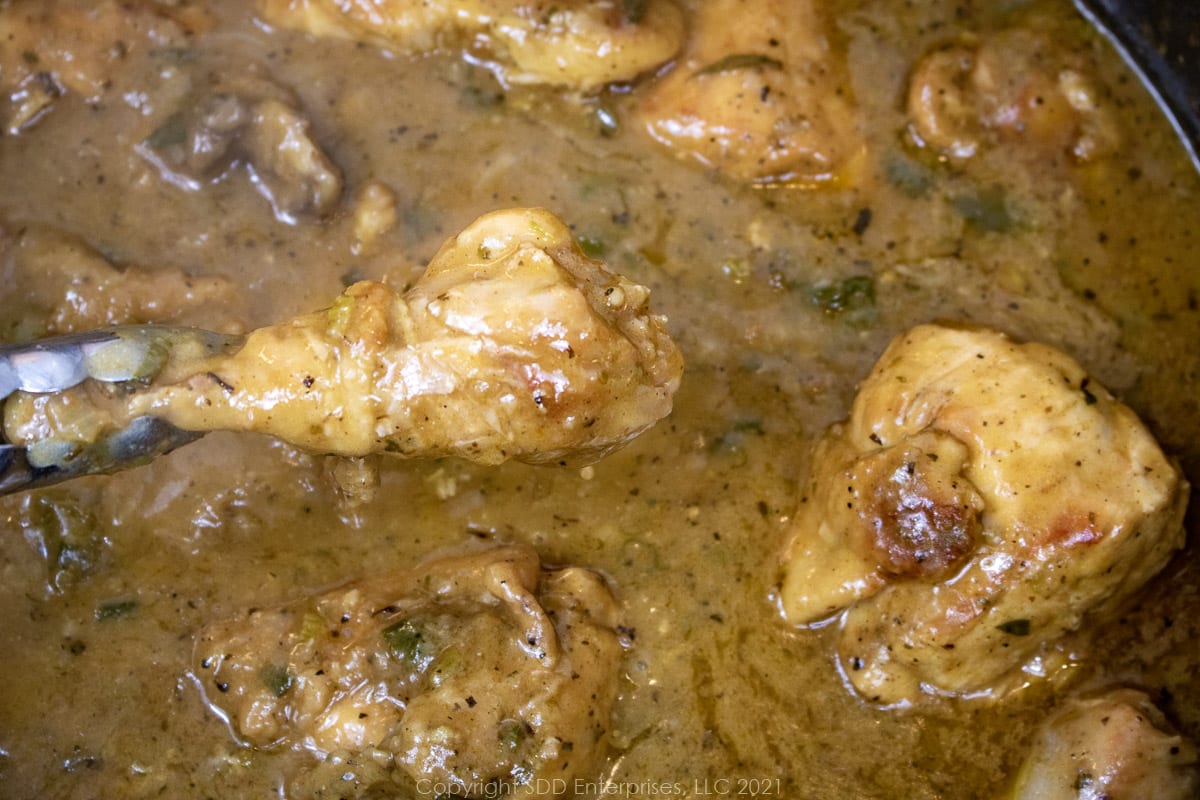
Follow us on Social Media and be sure to sign up HERE and we will deliver new recipes right to your inbox!
Hints and Tips
Yes, using a store-bought rotisserie chicken is a quick and easy way to make this recipe. Remove the skin and pull the meat off the bones. Make sure to use both the dark and the white meat. Shred the meat into bite-size pieces, sprinkle with some Creole seasoning and set it aside. Follow the recipe instructions (without browning the chicken first). After the gravy has simmered for about 30 minutes, add the cooked, shredded chicken. Let the shredded chicken simmer in the gravy for about 15 minutes before you finish with the green onions, parsley and butter.
Generally, you want to cut the chicken into 8 pieces: 2 breasts, 2 thighs, 2 legs and 2 wings. Depending upon the size of the pieces you can cut the breasts in half so that you have 4 breast pieces instead of 2. This will make sure all the pieces are relatively the same size and will cook at the same pace.
Yes, homemade stock is great to use. Follow my recipe for Homemade Chicken Stock. Use cut-up chicken to flavor the stock, but remove it from the stockpot after about 45 minutes. Let it cool, then pull the meat from the bones and sprinkle with Creole seasoning and set it aside. Return the bones and skin to the stock and simmer until it's done. Strain the stock and skim off any excess fat.
The gravy thickens because of the roux and the long cooking time. Make sure to have some extra stock to add in case the gravy is thickening more than you want. More wine or even water will work if you don’t have more stock. Using less oil and flour (say ¼ cup each instead of ½ cup) will make a thinner roux, but it’s mostly the cooking time. Make sure to keep the lid on and the heat low while you simmer the chicken. Of course, if you want a thicker gravy, remove the lid or offset it to partially open while the gravy simmers.
Leftover Smothered Chicken can be held in the refrigerator for 3 to 4 days. It can also be kept in the freezer for 4 to 6 months. The key to safe leftover storage, either in the fridge or the freezer is using an airtight container or a vacuum-sealed bag. Reheat on the stove or the microwave after defrosting overnight in the fridge.
Yes, the roux can be made with butter or bacon grease. Use the same quantity as the vegetable oil.
Smothered Chicken is perfect over long grain rice. It is also great over wide noodles, like egg noodles. Some great side dishes for Smothered Chicken are Creole Green Beans, Brabant Potatoes, Cajun Stuffed Potatoes and Macaroni and Cheese.
Use a dry white table wine, one that you would drink yourself. I usually use dry vermouth and I always stay away from "cooking wines". Besides dry vermouth, a couple of options are chardonnay and sauvignon blanc. You could also substitute dry sherry (this will affect the flavor profile a bit) for the dry white wine (1 for 1) or white wine vinegar (1 part wine to ½ part vinegar).
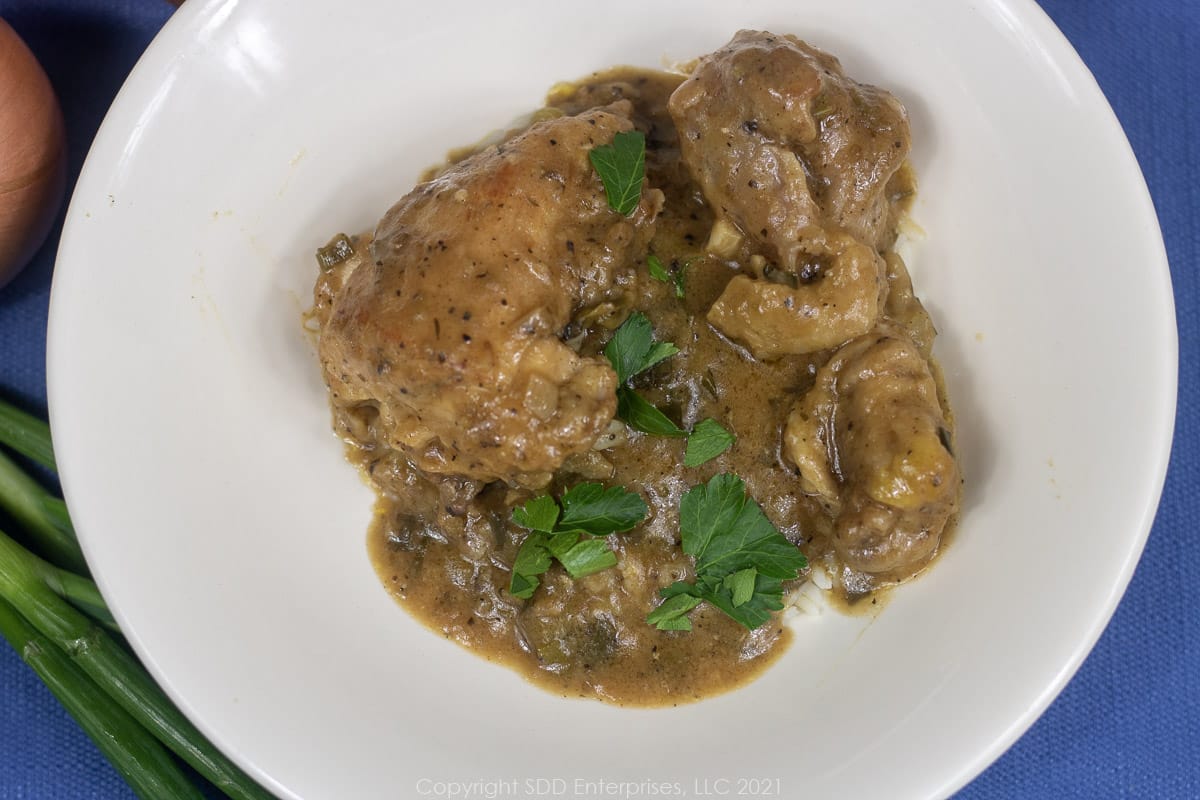
In the mood for more Creole and Cajun Chicken dishes?? Check these out:
If you make this recipe:
- Tell us about it in the Comments section below
- LEAVE A RATING ON THE RECIPE-worthy of 5-Stars?
- Questions or Comments? that’s the place!
- SIGN UP FOR OUR EMAIL UPDATES so you don't miss anything!
- Post a picture and share it with your friends on our Social Media:
Yeah You Right!
Recipe
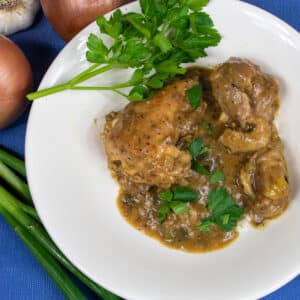
Cajun Smothered Chicken
Here's What You Need
- 1 chicken cut up into pieces - about 4 pounds-see Notes
- ½ cup AP Flour plus some for dusting the chicken
- ½ cup vegetable oil plus some to brown chicken
- 1 large yellow onion chopped
- 1 medium bell pepper chopped
- 2 stalks celery chopped
- 5 cloves garlic smashed
- 1 cup dry white wine
- 5 cups chicken stock see Notes
- 1 cup green onions about 1 bunch, chopped
- ¼ cup parsley chopped
- 2 tablespoons butter
Herb and Spice Blend
- 1 teaspoon dry oregano
- 1 teaspoon dry basil
- ½ teaspoon dry thymes
- 1 tablespoon Creole seasoning plus some for chicken
- ½ teaspoon cayenne pepper optional
- 1 teaspoon kosher salt plus some for chicken
- ½ teaspoon ground black pepper plus some for chicken
- 2 bay leaves
Here's What You Do
- Cut the chicken into serving pieces and sprinkle with Creole seasoning, kosher salt, and ground pepper, set aside.
- Coarsely chop the yellow onion, bell pepper and celery; and place all in the same prep bowl. Smash the garlic; measure all the other ingredients, set aside.
- Place about 2 tablespoons of vegetable oil in a Dutch oven over medium heat.
- Dredge seasoned chicken pieces in AP flour, shake off the excess and brown in the hot oil. Turn the pieces often to brown on all sides. This should be done in batches so you don't overcrowd the pan. Remove the chicken and set it aside.
- Maintaining a medium heat, add ½ cup of vegetable oil to the Dutch oven. When the oil is shimmering, add ½ cup of AP flour.
- Stir or whisk constantly to make a medium roux (peanut butter color), about 8 minutes.
- Add the Trinity (yellow onions, bell peppers, and celery) to the roux and mix together to coat all of the vegetables with the roux.
- Cook for about 8 minutes, stirring often until the onions are softened and beginning to get translucent.
- Add the garlic and the Herb and Spice Blend (without the Bay Leaves). Stir to combine and simmer until aromatic, about 2 or 3 minutes.
- Deglaze the bottom of the Dutch oven with about ½ cup of the white wine, making sure to mix all the fond into the gravy. Add the remaining wine and mix well.
- Simmer the wine for about 5 minutes, then slowly add the about 4 cups of the chicken stock, 1 cup at a time; reserve the remaining stock to add later if the gravy is too thick.
- Stir constantly as you add it to thoroughly blend the stock into the roux, making sure there are no lumps before adding more liquid.
- Once all the liquid is mixed into the roux, increase the heat to high.
- Add the bay leaves and maintain a medium boil for about 5 minutes, uncovered, stirring occasionally.
- Add the chicken back to the Dutch oven. Stir to coated all the chicken with the gravy. Once the gravy returns to a boil, reduce heat to a low simmer and cover.
- Simmer for 1 hour or until the chicken is falling off the bones, stirring regularly so the chicken does not stick.
- About 15 minutes before the chicken is done, add the green onions and parsley to the Dutch oven. Stir to combine and simmer until finished. When ready, remove from the heat and stir the butter until melted.
- If you want the gravy to be thicker, offset the lid while it simmers. If it is getting too thick, return the cover to the pot. Add the reserved stock if needed.
- Serve over rice.
Recipe Notes
Leftover Smothered Chicken can be held in the refrigerator for 3 to 4 days or the freezer for 4 to 6 months in an airtight container or a vacuum-sealed bag. Make sure the Smothered chicken cools down before storing. Reheat on the stove or the microwave after defrosting overnight in the fridge. Substitute the same quantity of butter or bacon grease for the vegetable oil.
Serve Smothered Chicken over long-grain rice. It is also great over wide noodles, like egg noodles. Use a dry white table wine, like dry vermouth, chardonnay, or sauvignon blanc. Stay away from "cooking wines". You could also substitute dry sherry (this will affect the flavor profile a bit) for the dry white wine (1 for 1) or white wine vinegar (½ cup vinegar for 1 cup wine).

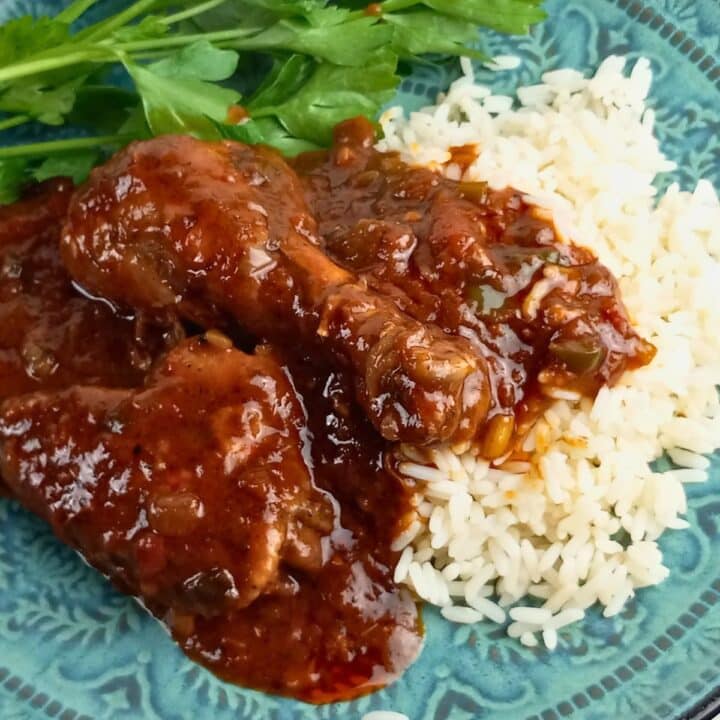
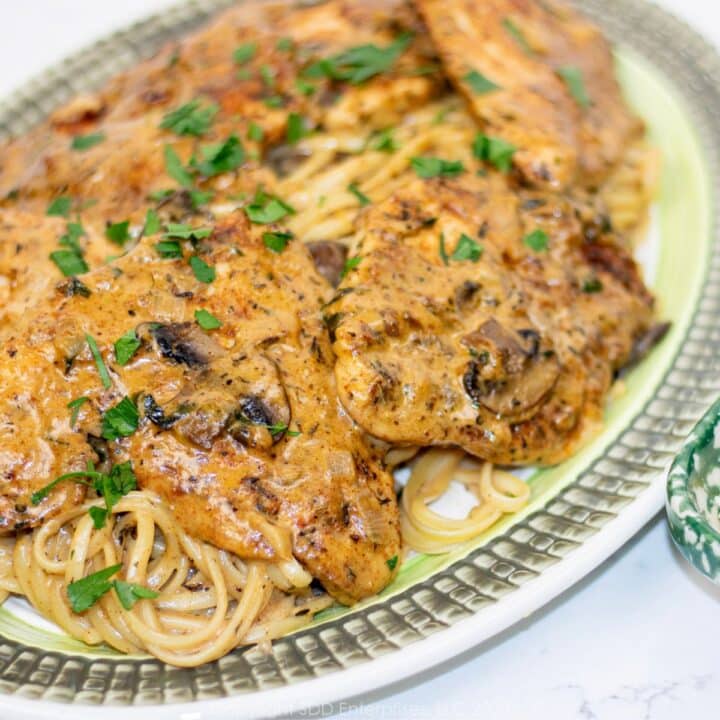
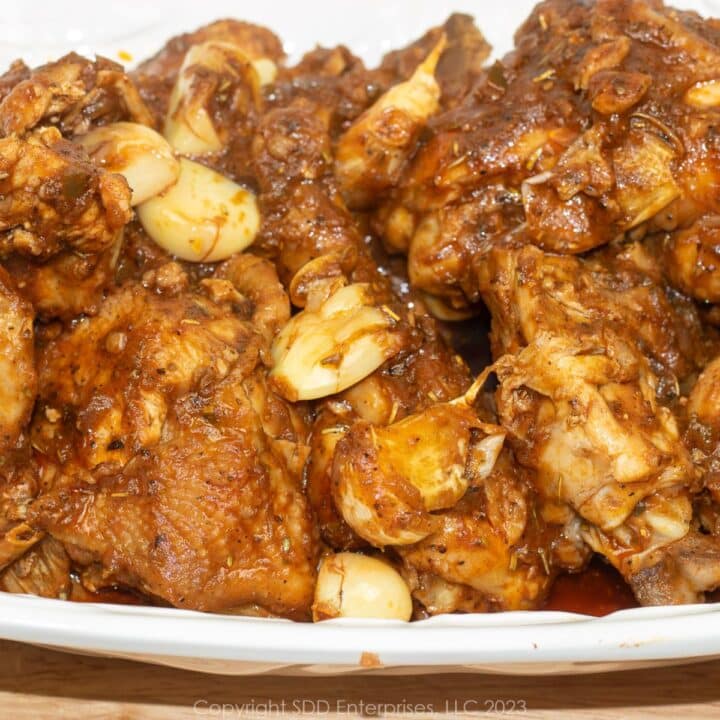
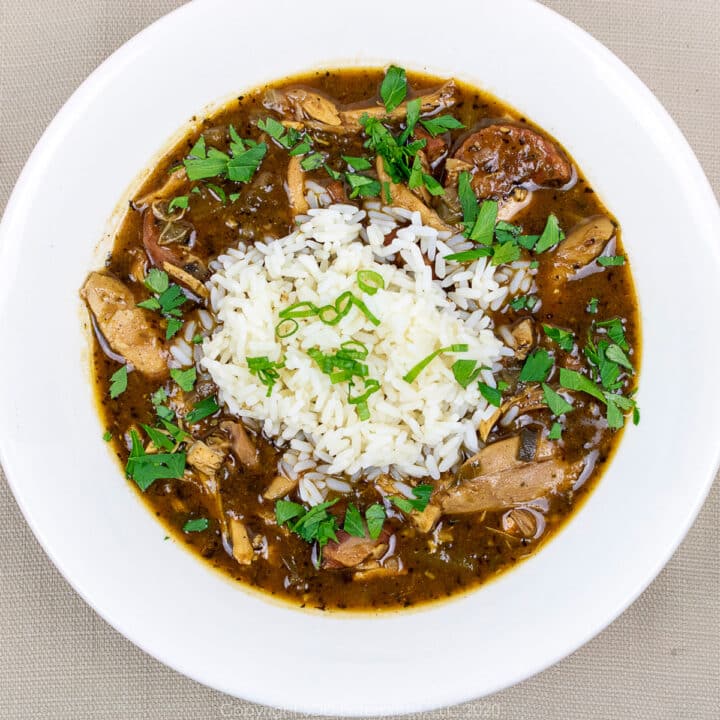
Gigi Fornerette
Absolutely delicious. Just like when I was growing up!!! I'm sooo glad I found this recipe. Thank you, thank you, thank YOU~~~!!!!
Sweet Daddy D
Thanks so much, Gigi! When a recipe can connect to our family or childhood, that is the highest compliment! Enjoy
kimberly
authentic cajun cuisine!!! I've been looking for this recipe !
Sweet Daddy D
Thanks, Kimberly. Enjoy!
Tony
A good friend’s wife cooked some smothered chicken a few months ago that was out of this world (her beat up Magnalite pots/pans did their job). I’ve been craving smothered chicken ever since.
Your recipe is great! The chicken was phenomenal (terrific, full flavor). I’ll admit the wine threw me for a second, but I elected to follow the recipe exactly as written (rare for me).
It is true that no people domestically are as fanatical about their ownership and posture around food than folks from Louisiana (Cajun or Creole). The French, Mexicans and Nigerians are pretty passionate as well.
In all cases, I would offer that simply renaming your recipe “Louisiana Smothered Chicken” eliminates any heartache around authenticity and appropriation. It then is simply your unique take on smothered chicken.
Thanks for taking the time, care and good spirit to share your recipe. I found it randomly on the internet and it looked to be what I was after.
Thanks again!
Sweet Daddy D
Tony...thanks for the thoughtful comments. I really appreciate you giving the recipe a shot and I'm thrilled you liked it. I find the discussion of the cultural aspects of food to be interesting and enlightening; that's part of the reason I do what I do. People of South Louisiana are definitely passionate about their food (as are other cultures). The fastest way to get in an argument is to tell a Cajun or Creole cook what to put and what not to put in their recipes. The culinary history of this region is extremely interesting but seen through today's lens, subregional variations will sometimes blur the lines between Cajun and Creole. That's part of the fun!
Thanks, Tony. Keep cooking!
Katherine Horton
Well I followed your directions exactly. Opened a summer Shandy, read the directions, and prepped everything!! Got it all together in the pot and beer number 2 while waiting for the chicken to simmer and cook. This was fantastic!! Even my 2 yr old granddaughter ate it up!! Thanks again for another fantastic recipe!!
Sweet Daddy D
Yeah you right, Katherine! Thanks for reaching out, so glad you, and especially your grandaughter, liked it. Hopefully, she'll be making it for her grandkids! Isn't it easier when you prepare yourself and prepare the ingredients beforehand? Thanks so much for the great review.
Derek Dunbar
Made your recipe tonight and it's exactly what I was looking for in a Smothered Chicken recipe! I don't care if it's called Cajun/Creole/Southern/Whatever Smothered Chicken recipe. It packs a ton of flavor and reminds me of the smothered chicken that my grandma use to make when I stayed with her over the summers in south Alabama. This recipe is a keeper for me and I look forward to making it again!. I'll be cooking more of your recipes in the future. Thanks!
Sweet Daddy D
Thanks, Derek. I am really glad you tried the recipe and loved it. I appreciate you reaching out with such kind remarks.
Micah C
This is a very good recipe. Not Cajun but very good in taste. Smothered chicken in most of Acadiana would not include a roux. You are right. Asyou get to Parishes closer to New Orleans, you may find variations but by in large, roux would not be in the recipe. Roux is used far less in Cajun cooking than one may think. The color and unique flavor in a true Cajun smothered chicken comes from browning the chicken. Using the easy method of roasted chicken could never give off the type of flavor or color as a raw chicken that is deeply brown, borderline burnt but not burnt. It is a technique that is as Cajun as you will find. It is the most common way of cooking in Acadiana. Whether round steak, pork chops or smothered chicken, browning is the place to get that one of a kind flavor.
Sweet Daddy D
Hey, Micah. Thanks for that interesting comment. Building flavor step by step, as you describe, is the key. One reason I love learning about Cajun (and Creole) Cuisine is learning about the variations. The method you describe sounds very traditional and I would love to learn more about it. It's likely you don't use printed recipes, but if you have some resources you can share ([email protected]), I'd love to add them to my research. Thanks for reaching out!
Michael W.
Going to make this soon. It has to be extremely delicious. I will inform you when. Thx for a great site and recipes.👍🏻👍🏻👍🏻
Sweet Daddy D
Yeah you right, Michael. Thanks!
Thogar
If anything this is Creole smothered chicken, it is not authentic Cajun at all.
Cajun here who's eaten smothered chicken made by at least a dozen different people while growing up and cooked it countless times myself. Never, ever in any of those instances did a real Cajun ever use basil, oregano, thyme, or bay leaves in their recipe.
First, as a classic Cajun dish it would never have most of those herbs in it. Salt, black pepper, cayenne - that's it, unless you might be in the mood to also add garlic and/or onion powder.
If you toss in those herbs (and wine!) into your smothered chicken any Cajun tasting it would calll you a couillion for adding Italian & seafood seasonings to chicken. My French-speaking, ESL Cajun grandmother would chase you with a large, wood spoon for making such a mistake and for inaccurately appropriating our culture.
Those not-really-Cajun additions sound like a Creole cook trying his hand at Cajun cooking and habitually adding Creole-common herbs. I'm sure, like gumbo with tomatoes (not Cajun, not ever), some not-Cajuns will find it appealing, but it is not authentic. And most Cajuns in Acadia Parish, where I was born, grew up, live, and learned to cook some 50 years ago, would tell you your smothered chicken is okay, but someone messed up the seasoning, a lot. (I mean, especially basil, oregano and bay leaf?! Are you serious? This isn't a seafood boil or even a seafood dish)
I'm sure your recipe is tasty to some, but it is most decidedly not authentic enough to have the name "Cajun" attached to it and is, in fact, something of an insult to a culture that appreciates its food as much as, or more than, any other culture in history.
Please stop destroying our heritage with inauthentic recipes. We've faced enough diaspora over the centuries and you're making it harder to showcase true Cajun culture by your well-meaning, but erroneous misrepresentation of it. Stick to Creole or check with some real Cajuns west of the Atchafalaya before publishing a "Cajun" recipe. Your Creole is showing and it's only a bad thing when you try to pass it off as Cajun and a Cajun sees it. The rest of the internet will, pardon the pun, eat it up, but that doesn't detract from the fact that this recipe is INauthentic.
I appreciate what you're trying to do here, but try to check your Creole at the door before you enter a Cajun kitchen and we'll all be better off for it. Thanks.
Sweet Daddy D
@thogar...how do you really feel?? Express yourself, let it out!! Just kidding, my friend.
I appreciate you reading the article and recipe. I also appreciate your feeling strongly enough to comment. Honestly, you make some valid points. I have a very similar ongoing conversation with my mother-in-law who does not care for my use of so many herbs. Her tastes are rooted in her upbringing on the German Coast when her Mother and Grand Mother did not use many herbs at all. Thank goodness she hasn’t chased me around with a large, wooden spoon yet, although she did gift me a large wooden spoon she’d had for years and I love it. She probably does call me a couyon, but only under her breath!
I love this topic. Your comments about the "Creole" in my cooking aren’t far off the mark. Obviously, you're a pretty astute observer of Cajun cuisine. I agree that a very authentic Cajun recipe originating decades ago and passed along through generations would never use as much or the types of herbs that I typically use. I also believe that in the heart of Cajun country, like your home in Acadia Parish, that is particularly true even today. But as we move east into areas like Lafourche and Terrebonne Parishes, as a reference, different influences may be reflected today. The line between Cajun and Creole is not as distinct as it was a century or more ago (although that may be less true in Acadiana). The influences of people like Chef Paul Prudhomme have something to do with that. Although he has deep roots in pure Cajun cuisine, his interpretation evolved as his meteoric rise brought Cajun cooking to many people around the world. His style of Cajun cuisine includes lots of herbs and spices, which ironically, he mastered in a Creole restaurant! Bottom line, I agree with you, @thogar, there’s a tendency for Creole influences to show in my Cajun offerings.
What defines Creole is much broader than what defines Cajun, in my opinion. To me, it’s all about learning and sharing and I’m always interested in learning more about authentic Cajun cuisine from "real Cajuns west of the Atchafalaya". Email ([email protected]) me some recipes you consider authentic, I want to learn more about your culinary heritage. While I try to develop recipes for 2021, the more authentic the roots are, the more valuable the experience will be. (I’m also interested in learning more about the roots of Creole cuisine, but that’s a different discussion).
Thanks for reaching out, I appreciate your insights. Try one of my recipes, adjust it the way you think it should be adjusted. You won’t forfeit your Real Cajun Card, I promise!
Randy J Wykle
I can not find how much butter and green onion are supposed to be used.
Sweet Daddy D
Shoot, Randy. Somehow those ingredients got cut off the recipe cards, Thanks for pointing that out. Use a bunch (about 1 cup) of green onions, 2 tablespoons of butter, and up to 1/4 cup of parsley. I appreciate you letting me know, I will update the recipe card right away. Thanks, and if you try the recipe, let me know what you think.